Training your abs is a fundamental part of growing and defining your stomach. Whether you are a workout enthusiast or creating your first training plan, the workouts below will help you meet your fitness goals.
weighted side bend (on stability ball)
_Waist_360.gif)
1. Start by selecting a weight that is challenging but manageable. This could be a dumbbell or a medicine ball.
2. Position the stability ball next to you and sit down on it. Carefully roll your body down onto the ball until your lower back is resting comfortably on it. Your feet should be flat on the floor, shoulder-width apart for balance.
3. Hold the weight in your right hand, letting it hang down at your side. Your left hand can be placed on your hip or extended out for balance.
4. Slowly bend to the right side, allowing the weight to lower towards the floor. Keep your abs engaged and make sure you're bending from the waist, not the hips.
5. Once you've bent as far as is comfortable, use your abs to pull your body back up to the starting position.
6. Repeat this movement for your desired number of reps, then switch the weight to your left hand and repeat the exercise bending to the left side.
Remember to keep your movements slow and controlled, focusing on the contraction of your abs. Avoid any jerky or fast movements to prevent injury.
weighted seated twist (on stability ball)
_waist_360.gif)
1. Start by selecting a weight that is challenging but manageable. This could be a medicine ball, dumbbell, or weight plate.
2. Sit on a stability ball with your feet flat on the floor. Your knees should be bent at a 90-degree angle and your back should be straight.
3. Hold the weight with both hands at chest level. Make sure your grip is firm but not too tight.
4. Engage your abs and slowly twist your torso to the right, keeping your back straight and your gaze forward. The movement should come from your abs, not your arms or shoulders.
5. Hold the twist for a moment, then slowly return to the center.
6. Repeat the twist on the left side. This completes one rep.
7. Aim for 10-15 reps, or as many as you can do with good form.
Remember to breathe throughout the exercise, exhaling as you twist and inhaling as you return to center. Keep your movements slow and controlled to maximize the effectiveness of the exercise.
weighted russian twist v. 2
To perform the Weighted Russian Twist V. 2, follow these steps:
1. Start by sitting on the ground with your knees bent, pull your abs to your spine, and lean back a few inches while keeping your back straight.
2. Hold a weight with both hands. It can be a dumbbell, medicine ball, or any other weighted object you're comfortable with.
3. Lift your feet a few inches off the ground and bend your knees slightly. This is your starting position.
4. Twist your torso to the right and touch your weight to the ground next to your body.
5. Then twist your torso to the left and touch your weight to the ground next to your body.
6. That's one rep. Make sure to keep your abs engaged and your back straight throughout the exercise.
7. Aim for 3 sets of 10-15 reps each, or as many as you can manage with good form.
Remember, the key to this exercise is the twist - you should be rotating your entire torso, not just your arms. This will ensure you're really working your abs. Also, make sure to keep your movements controlled, don't use momentum to swing the weight from side to side.
weighted russian twist (legs up)
_waist_360.gif)
1. Start by selecting a weight that you're comfortable with. This could be a dumbbell, medicine ball, or weight plate.
2. Sit down on the floor or a mat with your knees bent and your feet flat on the ground.
3. Lean back slightly so your torso is at a 45-degree angle to the floor. Make sure to keep your back straight and not rounded.
4. Lift your feet off the ground and cross them at the ankles. Your legs should be hovering about 6 inches off the ground. This is your starting position.
5. Hold the weight with both hands at your chest. If you're using a dumbbell, hold it by the ends. If you're using a medicine ball or weight plate, hold it on the sides.
6. Twist your torso to the right and touch the weight to the floor next to your body.
7. Then, twist your torso to the left and touch the weight to the floor on your left side. Make sure to keep your legs and hips as still as possible, the movement should come from your abs.
8. Continue alternating sides for the desired number of reps. Each twist to the left and right counts as one rep.
9. Remember to keep your abs engaged throughout the exercise and don't let your back round.
10. After completing your reps, carefully lower your feet back to the ground and set the weight aside.
Remember, the key to this exercise is control, not speed. Make sure to perform each twist slowly and deliberately, focusing on the contraction of your abs.
weighted russian twist
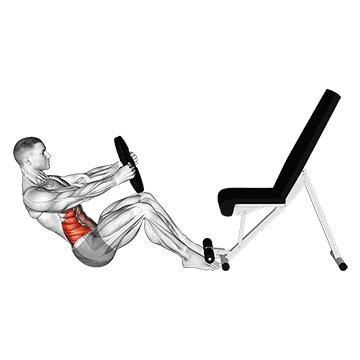
To perform the Weighted Russian Twist, follow these steps:
1. Start by sitting on the ground with your knees bent, pull your abs to your spine, and lean back a few inches while keeping your back straight.
2. Hold a weight with both hands. It can be a dumbbell, medicine ball, or any other weighted object you're comfortable with.
3. Lift your feet off the ground and cross them at the ankles. You should now be balancing on your sit bones.
4. Twist your torso to the right and touch your weight to the ground next to your body.
5. Then twist your torso to the left and touch your weight to the ground next to your body.
6. That's one rep. Aim to do 3 sets of 10-15 reps, or as many as you can manage with good form.
Remember to keep your back straight and not to let your knees sway as you twist. The movement should come from your abs, not your arms. Breathe out as you twist, and breathe in as you return to center.
This exercise targets your abs but also works your lower back and obliques. It's a great way to add some variety to your core workout.
weighted overhead crunch (on stability ball)
_Waist_360.gif)
1. Start by selecting a suitable weight. If you're new to this exercise, start with a lighter weight to avoid straining your neck or back.
2. Sit on a stability ball with your feet flat on the floor. The ball should be positioned under your lower back.
3. Hold the weight with both hands and extend your arms straight up towards the ceiling. This is your starting position.
4. Engage your core and crunch your upper body towards your knees. As you crunch, keep your arms straight and raise the weight towards the ceiling.
5. Hold this position for a moment, ensuring your abs are fully contracted.
6. Slowly lower your body back to the starting position, keeping your arms straight and the weight above you.
7. Repeat this movement for the desired number of repetitions.
Remember to keep your movements controlled and steady. Avoid using your neck or shoulders to lift the weight; the power should come from your abs. Breathe out as you crunch up and breathe in as you return to the starting position.
weighted hanging leg-hip raise
1. Start by selecting an appropriate weight. If you're new to this exercise, start with a lighter weight and gradually increase as you get stronger.
2. Secure the weight between your feet. This could be a dumbbell or a weight plate. Make sure it's secure so it doesn't slip during the exercise.
3. Find a pull-up bar or a similar piece of equipment where you can hang freely. Grip the bar with both hands, shoulder-width apart. Your palms should be facing away from you.
4. Hang from the bar, keeping your body straight. This is your starting position.
5. Slowly raise your legs, keeping them straight, until they are parallel with the floor. Make sure to engage your abs during this movement. The weight should add extra resistance, making your abs work harder.
6. Hold this position for a second, then slowly lower your legs back to the starting position. Make sure to control the movement to avoid swinging.
7. Repeat the exercise for the desired number of repetitions.
Remember to breathe during the exercise. Inhale as you lower your legs and exhale as you raise them. Also, keep your head and neck relaxed to avoid strain.
This exercise can be challenging, especially with added weight, so make sure to start with a weight you can handle and increase gradually as you get stronger.
weighted front plank
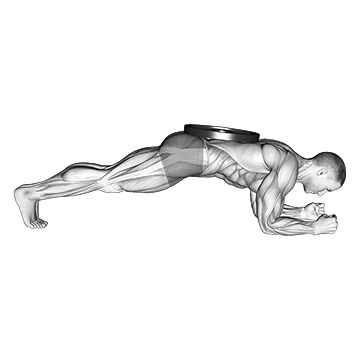
1. Start by selecting a weight that is challenging but manageable. This could be a weight plate, dumbbell, or a weighted vest.
2. Get into a standard plank position. This is done by positioning yourself on the floor as if you're about to do a push-up, but instead of placing your hands on the floor, rest on your forearms. Your body should form a straight line from your head to your feet.
3. Once you're in the plank position, have a partner carefully place the weight on your lower back. If you're using a weighted vest, put this on before getting into the plank position.
4. Engage your abs by pulling your belly button in towards your spine. This will help to stabilize your body and protect your lower back.
5. Hold this position for as long as you can, aiming for at least 30 seconds to start with. As your strength improves, try to increase the time you can hold the plank.
6. To finish the exercise, carefully remove the weight from your back and gently lower yourself back to the floor.
7. Rest for a minute or two, then repeat the exercise. Aim for 3 sets of 30 seconds to start with, gradually increasing the time and weight as your strength improves.
Remember to keep your body straight throughout the exercise and avoid letting your hips drop. If you feel any discomfort in your lower back, stop the exercise immediately.
weighted decline sit-up
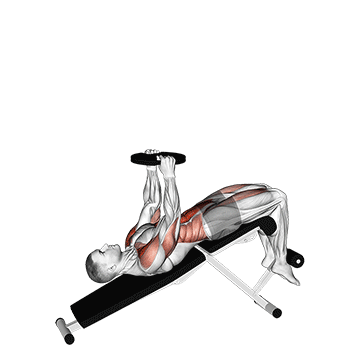
To perform the weighted decline sit-up, start by setting up your decline bench at an angle that is challenging, but still allows you to perform the exercise with proper form.
Next, select a weight that is suitable for your fitness level. This could be a weight plate, dumbbell, or medicine ball.
Sit on the decline bench and secure your feet under the pads. Hold the weight against your chest. If you're using a weight plate or dumbbell, hold it with both hands. If you're using a medicine ball, you can hold it with one or both hands, depending on its size and weight.
Lean back to lie down on the bench, keeping the weight against your chest. This is your starting position.
Engage your abs and sit up by raising your upper body towards your knees. Keep the weight against your chest as you do this. Ensure your back remains straight and your movements are controlled.
Pause at the top of the sit-up, then slowly lower yourself back down to the starting position.
Remember to breathe in as you lower yourself down and breathe out as you sit up.
Repeat this movement for your desired number of reps.
Ensure you maintain proper form throughout the exercise to effectively target your abs and prevent injury. If the weight becomes too heavy or if you're unable to maintain form, reduce the weight or perform the exercise without any weight until your strength improves.
weighted crunch
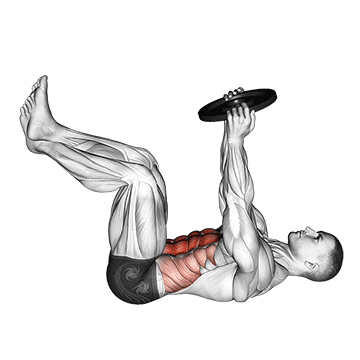
To perform the weighted crunch, start by lying flat on your back on a gym mat or comfortable surface. Bend your knees and keep your feet flat on the floor. Hold a weight plate or dumbbell across your chest with both hands.
Engage your core and lift your upper body towards your knees, keeping your lower back pressed into the floor. Ensure that the movement is controlled and you're not using momentum to lift yourself.
Pause at the top of the movement, squeezing your abs. Then, slowly lower yourself back down to the starting position.
Remember to breathe out as you crunch up and breathe in as you lower yourself back down.
Repeat this movement for your desired number of repetitions.
Ensure that the weight you're using is challenging but allows you to maintain proper form throughout the exercise. If you're new to this exercise, start with a lighter weight and gradually increase as your strength improves.
Always consult with a fitness professional if you're unsure about the correct form to prevent any potential injuries.
otis up
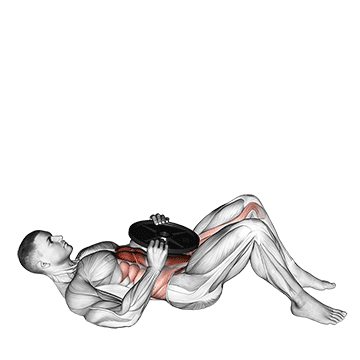
To perform the Otis Up exercise, follow these steps:
1. Start by lying flat on your back on a comfortable, flat surface. Hold a weight plate or dumbbell across your chest with both hands. Your knees should be bent and feet flat on the floor.
2. Engage your core and lift your upper body off the floor, pushing the weight towards the ceiling. Keep your neck relaxed and avoid straining it.
3. As you lift your upper body, simultaneously lift your knees towards your chest. Your body should form a V shape at the top of the movement.
4. Hold this position for a second, then slowly lower your upper body and legs back to the starting position. Ensure that your movements are controlled to maximize the effectiveness of the exercise.
5. Repeat this movement for your desired number of repetitions.
Remember to breathe throughout the exercise, exhaling as you lift your body and inhaling as you lower it. Always ensure that your movements are controlled and steady, and avoid using momentum to lift your body. The weight should be challenging but manageable, and you should be able to perform the exercise with good form.
No tags for this post.
